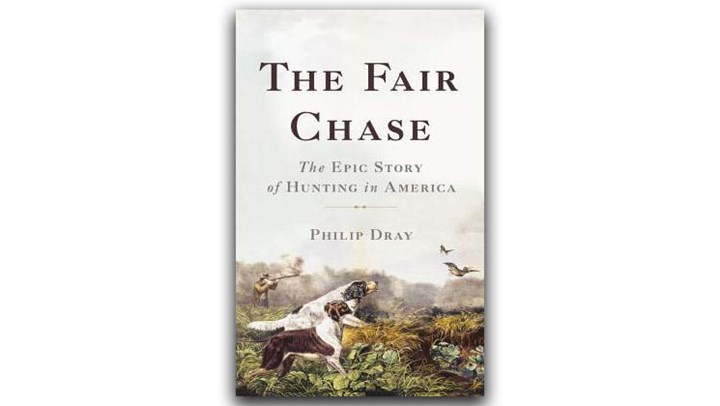
by Frank Miniter - Thursday, July 5, 2018

It is easy to dismiss “The Fair Chase” by Philip Dray. Just flip to the book’s Acknowledgements section and you’ll find sentiments such as: “The HSUS [Humane Society of the United States] does thoughtful and compassionate work in the fields of animal and wildlife protection, and its bimonthly publication, All Animals, is well worth a subscription.”
HSUS is of course the leading animal rights extremist organization and is avowedly anti-hunting.
Dray received a grant from the National Endowment for the Humanities to research and write this book. That is fitting, as this book is an academic attack on hunting.
The publisher (Basic Books) sent me a copy of this book and I am thankful for that, as I am happy I didn’t put a penny in Dray’s pocket for a copy of this dishonest attack on hunters and hunting.
I wish he had stumbled into a copy of my book “The Politically Incorrect Guide to Hunting,” as it would have burst many of his conclusions. Sure, maybe he wouldn’t have been intellectually honest enough to print them anyway, but I like to think that knowing, really knowing, he is a propagandist pandering to the left’s intelligentsia just might lower the tilt of his nose, at least when he travels outside his urbane milieu.
The thing is I am also glad I did read this book. Mostly because I like confronting other points of view, even when they are dishonest. For points of view to be proven true or false they must constantly confront opposing views. I am also glad I read this because the first two-thirds of the book is filled with interesting research and some honest fact-finding.
For a good while I was hoping that Dray would go through a metamorphosis similar to what Ken Stern experienced. Stern once ran NPR. As a man firmly on the left he wanted to understand “Red America,” so he started researching by leaving his well-to-do urban enclave located just outside Washington, D.C. He ended up writing “Republican Like Me: How I Left the Liberal Bubble and Learned to Love the Right.” That book is still wrong about a lot, but in it Stern took several big steps toward an honest and learned perspective.
In his book Dray seems like he was on the same road as Stern. Then all of a sudden he seems to have made the calculation that he just wouldn’t be popular in Brooklyn coffee shops and cocktail parties if he didn’t turn his back on much of what he had found.
In the last third of the book Dray gets particularly dishonest and one-sided. He treats hunting as something quant, passé and sinful to an enlightened mind. He argues by quoting animal-rights activists who say we must evolve away from hunting.
“How much better might it be to not merely avoid harming animals, but fully accept their interconnectedness with us,” he writes, “and constructively engage them as ‘neighbors, friends, co-citizens and members of communities.’”
He thereby makes the animal-rightist’s argument that squirrels, pigs, deer and butterflies should have the same rights, as in equal protection under the law, as people do.
The legal problems with that nonsense aside, he misses (maybe purposely) the glaring fact that hunters understand and cherish their interconnected role in nature. A balance must be struck. Hunters, whose seasons and bag limits are controlled by wildlife biologists, act as predators in ecosystems in order to maintain a healthy balance. We don’t live apart from deer, rabbits, geese and more; we live together. Any farmer could tell you that. And if you tell the farmer he or she can’t kill deer or anything else that is eating his or her crops, then that farmer will either break the law to protect his or her livelihood or build fences, mow down habitat the deer hide in by day and more to protect crops. This would do great harm to wildlife and to ecological diversity.
This is why the ethical and moral balance with nature is maintained by hunters, not by animal-rights activists who want to allow horses to file lawsuits. (Well, people one presumes would have to file them on the horses’ behalf. After all, aside from the talking horse in the 1960s sitcom “Mr. Ed,” I’ve never heard of a horse that could testify in court.)
Next comes Dray’s dishonest attacks on the NRA. He uses anti-gunners’ divide-and-conquer approach by arguing that most hunters are okay with banning the most popular firearms sold today: semiautomatic designs. He doesn’t cite any surveys or anything at all to make this claim. He simply deems it to be true based on a few anecdotal observations.
He even makes disproven claims that in the early 20th century “the federal judiciary’s reading of the Second Amendment was that it protected a collective right to gun ownership… .”
His anti-gun rhetoric is so intellectually weak it wouldn’t pass any honest peer review.
Dray thereby ends his arguments by drowning them in what was at times an interesting book. His last chapters—particularly “The Guns of Autumn”—succumbs to cherry-picked research and one-sided analysis clearly written to please his circles. The book isn’t just a disappointment, it is a tangle of half-truths that in the end turns into anti-gun and anti-hunting propaganda.
■ ■ ■
Editor's Note: NRAHLF.org contributor Frank Miniter is the author of multiple books including "The Politically Incorrect Guide to Hunting," "This Will Make a Man of You: One Man’s Search for Hemingway and Manhood in a Changing World," "The Future of the Gun" and the New York Times' Bestseller "The Ultimate Man’s Survival Guide."
E-mail your comments/questions about this site to:
[email protected]
